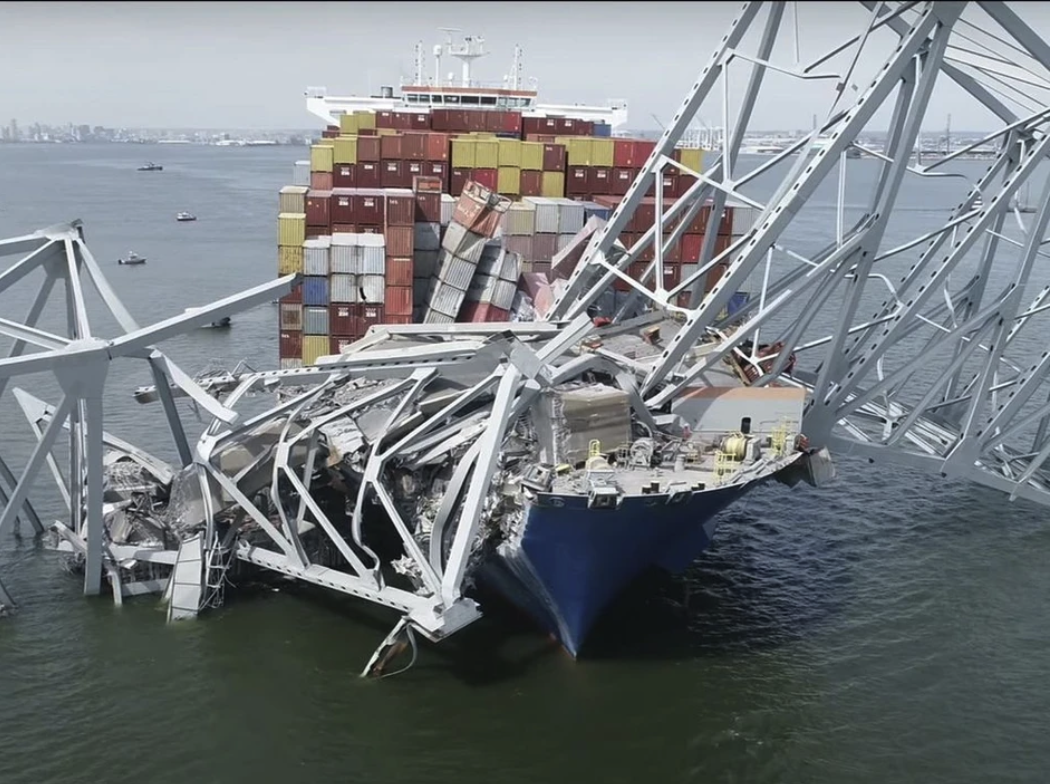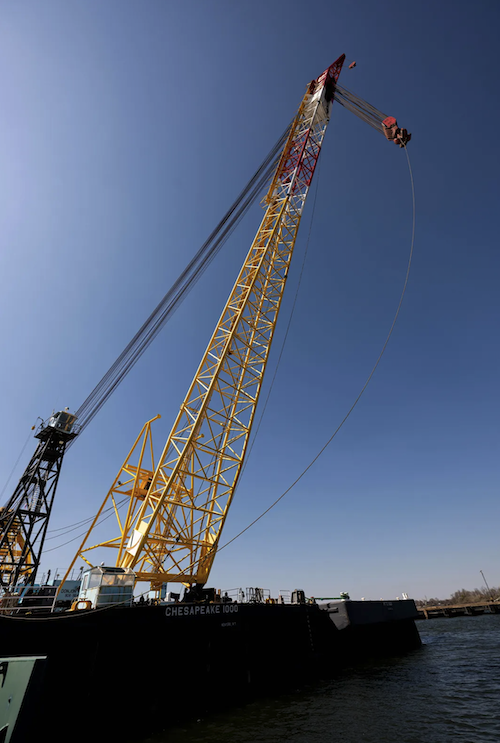
Cleanup efforts are underway in Baltimore, where the Francis Scott Key Bridge collapsed into the Patapsco River last month after being struck by a cargo ship.
Removing pieces of the mangled bridge from the river will be a massive undertaking that could take weeks. To help with this process, officials are bringing in several large cranes, including one with an unusual past: the Chesapeake 1000
More than 50 years ago, the Chesapeake 1000 (originally dubbed the Sun 800) played a vital role in a secret CIA mission called Project Azorian, a multi-year effort to recover a sunken Soviet submarine, according to the Washington Post’s Dan Rosenzweig-Ziff and Praveena Somasundaram.
 The 1,750-ton vessel, called K-129, disappeared in the Pacific Ocean in 1968. United States officials eventually found it submerged 16,500 feet deep, roughly 1,800 miles northwest of Hawaii.
The 1,750-ton vessel, called K-129, disappeared in the Pacific Ocean in 1968. United States officials eventually found it submerged 16,500 feet deep, roughly 1,800 miles northwest of Hawaii.
“It was thought that there was at least one nuclear weapon aboard the sub,” Todd Bennett, a historian at East Carolina University who wrote a book about the project, tells NPR’s Kathryn Fink. “And even more importantly, the portion of the sub that the CIA targeted contained a code room, a working code machine and then materials it was thought that explained how that device worked.”
Officials wanted to recover this information; they also wanted to gain insight into the Soviet submarine manufacturing process to improve their ability to detect the stealthy vessels. But first, they needed to bring the sub to the surface.
Enter Project Azorian. The CIA hatched an ambitious plan to build a ship with a powerful hydraulic system and a claw that could lift the wreckage from the depths.
“To discover [the submarine], that’s one thing,” Bennett tells the Associated Press’ Ben Finley. “But to have the wherewithal to try to devise a way to recover that piece of hardware is really remarkable. It’s been compared—and rightly so—to an underwater moonshot.”
So as not to alert the Soviets, the CIA devised a cover story involving Howard Hughes, the billionaire aerospace engineer and film producer. To everyone outside the CIA, it would appear that Hughes was building a 618-foot-long vessel called the Hughes Glomar Explorer for deep-sea mining.
The ship was constructed at Sun Shipbuilding and Drydock Co. in Chester, Pennsylvania, where workers also had no idea they were involved in a covert mission. As part of this process, the team created the Sun 800, a floating derrick that could lift heavy parts onto the vessel, reports the Maritime Executive.
The crane was named for the number of tons it could lift. For example, the Sun 800’s “signature achievement” was hoisting the Glomar Explorer’s 630-ton gimbal during construction, per the Washington Post.
In 1973, the Glomar Explorer sailed for the first time, traveling from Pennsylvania toward Bermuda for testing, as Smithsonian magazine’s Lila Thulin wrote in 2019. After sailing around South America, it arrived in Long Beach, California, where it was loaded with equipment.
The giant claw was built separately in Redwood City, California, on a barge called HMB-1. In the spring of 1974, HMB-1 and the Glomar Explorer met up near Catalina Island for the claw handoff.
A few months later, the Glomar Explorer headed to the wreckage of K-129. Crews lowered the claw “by adding 60-foot sections of supporting steel pipe, one at a time,” per the CIA. “When it reached the submarine section, the capture vehicle then had to be positioned to straddle the sunken submarine section, and its powerful jaws had to grab the hull.”
The sub ultimately broke apart during this process. Crews were able to recover only about a third of it, along with the bodies of six Soviet submariners. They gave the men a formal military burial at sea.
Unfortunately, Project Azorian didn’t turn up any significant intelligence—at least according to the CIA.
“The conventional wisdom has become that this was a failed mission,” Vince Houghton, former curator of the International Spy Museum, told Smithsonian in 2019. “[The CIA has] allowed that belief to be what everyone understands, but why would they not? I always say, ‘We have no idea what they got.’”
Media outlets learned of Project Azorian in early 1975, when thieves broke into Hughes’ office and stole documents related to the mission. Early news stories were filled with errors: For example, reporters called the mission “Project Jennifer.”
Plans to return to the site and recover the rest of the sub were ultimately quashed. The Glomar Explorer was later renamed and used for deep-sea oil drilling and exploration.
The Sun 800 wasn’t present for the recovery attempt, but it “played an essential role in making it happen,” as the Maritime Executive writes. In 1993, the crane found a new home with current owner Donjon Marine Co. Inc. The company refurbished it and renamed it the Chesapeake 1000, as it can now lift up to 1,000 tons.
Since then, the Chesapeake 1000 has helped with other big projects, including recovery efforts after Hurricane Sandy, per the Washington Post. Now, in Baltimore, it’s “on standby for when we need to go to larger lifts,” said U.S. Navy Captain Sal Suarez, who is leading the salvage operations, at a news conference, as reported by the Baltimore Sun’s Abigail Gruskin.
The crane’s primary purpose will be lifting pieces of the bridge that fell onto the cargo ship, per the Washington Post. It has its work cut out for it: In total, those pieces weigh about 3,000 to 4,000 tons.
Source: smithsonianmag.com. Author: Sarah Kuta

